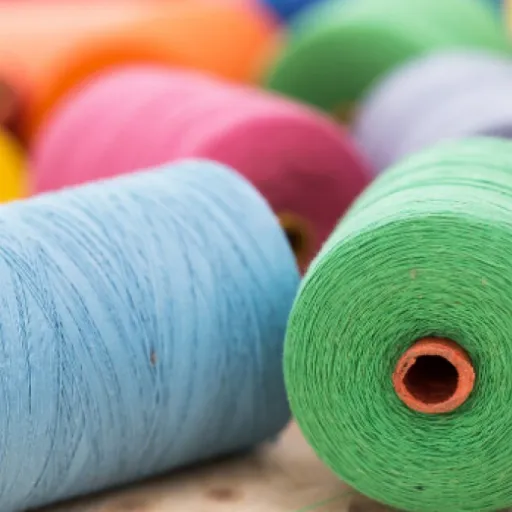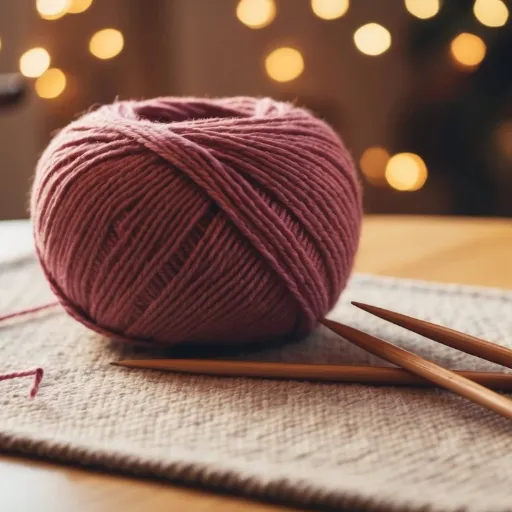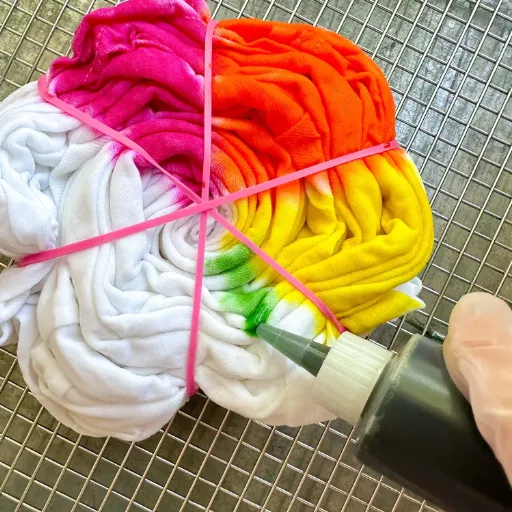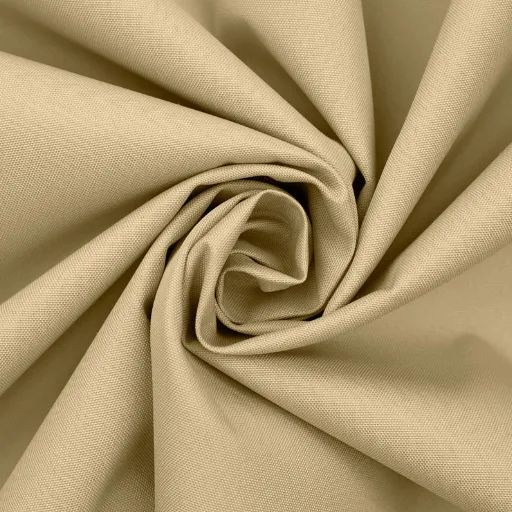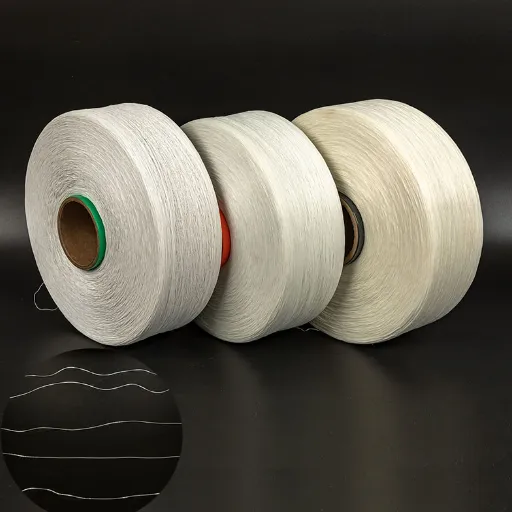The textile industry has made polyester yarn one of its most important materials because of its flexibility, strength and low price. Among the different kinds, filament polyester yarn and its variations are especially noticeable due to their specific features and the extent of their applications. It does not matter if you are a producer, a designer, or just a person who wants to know more about the fabrics that surround us; knowing these yarns is a must. This article takes you to the world of polyester yarns, where the distinctions, properties and uses are carefully and clearly laid down; hence, it gives you an all-in-one guide. Get ready to see how these fibers are not only the basis of the textile industry but also the source of consumers’ desires for both practicality and aesthetic appeal.
Introduction to Polyester Yarn
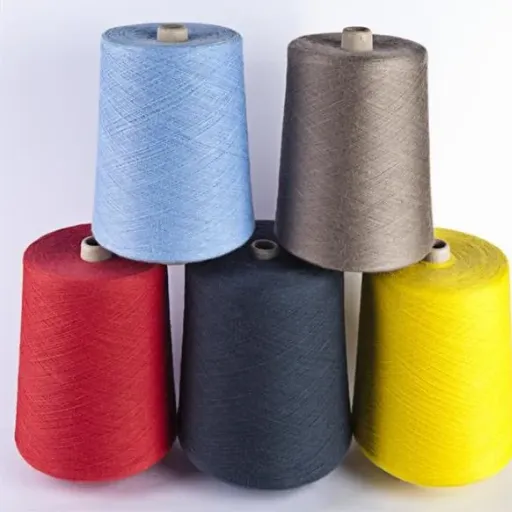
What is Polyester Yarn?
Polyester yarn is a synthetic fiber that is mainly derived from petrochemical-based polymers, like polyethylene terephthalate (PET). The textile industry extensively uses this fiber because of its versatility, durability, and low cost. The manufacture of polyester yarn is carried out through a chemical process known as polymerization, wherein the monomers are linked together chemically to form long chains of polymers, and further spun into fibers.
One of the polyester yarn’s key distinctive traits is the fact that it is very strong and almost unbreakable, while at the same time being resistant to stretching, shrinking, and wrinkling. These features of the polyester yarn make it a very good choice for a variety of uses, such as clothing, upholstery, and other industrial fabrics. Besides, polyester is hydrophobic, which means that it does not attract water, and consequently it dries quickly, thus making it a perfect material for activewear and outdoor equipment.
Moreover, Polyester yarn has its strengths and weaknesses but is still preferred for its versatility. The yarn is suitable for being mixed with other fibers like cotton or wool to give particular characteristics like increased breathability or softness. The very capacity of holding brilliant colors and standing wear over time, which is the case of polyester, is one of the reasons it remains one of the most sought-after materials in the world’s textile industry.
Polyester’s Significance in the Textile Industry
Durability, cost-effectiveness, and versatility are the three characteristics that make polyester the principal fiber of the textile industry. This man-made fiber is capable of enduring a few washings, stretching, and singeing; thus, it is the best choice for making long-lasting garments. Furthermore, its great quality, as well as its ability to remain in shape and endure repeated washings without losing the quality of the fabric greatly enhance the everyday use of polyester.
Key Benefits of Polyester in Textiles
- ✓ Compatible with other fibers, frequently combined with natural fibers like cotton and wool to improve feel and quality
- ✓ Low moisture absorption and quick-drying characteristics make it suitable for sportswear and outdoor gear
- ✓ Non-fading nature and vibrant colors ensure fabrics withstand the test of time
- ✓ Practicality and versatility keep its importance in today’s textile market
Overview of Types of Polyester Yarn
Polyester yarn is available in several types importantly adjusted to particular applications and industries. The two main types of polyester yarn are filament yarn and spun yarn. Filament yarn is made of long, continuous fibers that are smooth and uniform, thus it is mainly used for sewing threads, lightweight fabrics, and upholstery. Spun yarn, meanwhile, is made by twisting staple fibers together which produces a softer texture that can be used in apparel and home textiles.
Tensioned filament yarn is one specific example that gets special treatment for bulkiness and elasticity, thus becoming an ideal candidate for non-peeled fabrics to be used in sports apparel and underwear. Additionally, there exist high-tenacity polyester filament yarns, which are the strongest and most durable among them, so they are used in the production of industrial products e.g., ropes, seatbelts, and tire cords. In the same way, spun polyester yarns can have a cotton mix to provide the advantages of softness, strength, and affordability at the same time.
In recent years, recycled polyester has also become a popular choice among yarns because of its eco-friendly properties. Recycled polyester yarn is obtained from plastic bottles or industrial waste, so it contributes less to the landfill and requires less energy for its production. It has the same performance properties as conventional polyester, hence it offers sustainability without the quality compromise. All these different types of polyester yarn highlight a certain flexibility in their use and make it easier to meet the new challenges of consumer and environmental requirements in different industries.
Types of Polyester Yarn

Filament Polyester Yarn
The filament polyester yarn is made up of smooth long, continuous strands of polyester fibers. Continuous filaments add smoothness and strength to the yarn making it a suitable choice for applications where one needs to be able to withstand use and have a very fine finish. The structure of the yarn also gives it high tensile strength, which other materials cannot stand when being used in production, abrasion resistance, and its ability to retain the original shape over time.
The use of this kind of yarn is very common in the textile industry, particularly in the production of light, shiny, and silky fabrics such as satin, taffeta, and georgette. Needless to say, the yarn is also up in the production of non-textile items like seat belts, ropes, and tire cords; it is playing a significant role due to its durability and resilience. Being so adaptable, it is preferred for both functional and decorative uses.
Filament polyester yarn sustainability can be enhanced through the adoption of recycled polyester which cuts its environmental footprint, and thus it can be made without virgin polyester. The physical and performance properties of the yarn make it a versatile material that satisfies the modern demands of the industry whilst at the same status of being eco-friendly.
Textured Polyester Yarn
Textured polyester yarn is a very specific yarn that is made by a method known as texturizing, whereby straight filaments are made into thicker and more elastic yarns. The yarn’s characteristics are improved through the texturing process and it is given a soft feel, higher durability, and improved stretching. Textured polyester yarn is commonly used in places where comfort and strength are needed, like in clothes, house furnishings, and activewear.
One of the most important benefits of textured polyester yarn is that it allows the air to pass through and it is good at controlling the moisture. With these characteristics, the yarn can draw the sweat away from the body, thus it can be used for making activewear and other fabrics meant for performance. Besides, the bounce back of the yarn also helps the garments to fit and be relaxing to wear, which are the main factors for industries that care about their customers’ satisfaction.
The making of textured polyester yarn has also welcomed eco-friendly practices in the past few years. However, to cut the carbon emissions of the final product, manufacturers are more frequently mixing recycled polyester with the texturizing process. This transition not only contributes to less waste and resource exhaustion but also meets the rising cravings of both the fashion and the consumer world for green textiles. Textured polyester yarn, with its distinct features and sustainable prospects, is still a crucial raw material for the production of textiles that are both innovative and environmentally friendly.
Fully Drawn Yarn (FDY)
Fully Drawn Yarn (FDY) is a polyester textile fiber that has passed through the entire spinning and drawing process, and thus a yarn with a uniform structure and improved mechanical properties is produced. This yarn is highly valued for its smoothness, strength, and longevity making it the perfect choice for high-quality fabric applications. FDY is very much in demand for weaving and knitting, as it serves as the source of the textile families for clothes and home furnishings.
The luster and uniformity of the fabric made from FDY is one of its greatest advantages. In fact, each of the FDY’s different finishes, such as semi-dull, bright, or fully bright, brings a different luster and appeal different from each other. Moreover, the ability of FDY to resist wear and tear under a variety of environmental conditions has made it a popular choice in different industries.
Also, the energy consumption during the production of the FDY yarn is lower than that of the conventional yarn and thus the production of this type of yarn can be combined with other eco-friendly practices like the use of recycled polyester. Thus, the demand for environmentally friendly innovations in textiles is in keeping with the trend that is getting stronger and stronger. FDY is indeed a crucial factor in the market that can reconcile the performance and the sustainable aspect and hence it will be one of the support measures for the ongoing shift towards eco-friendly textile solutions.
Draw Textured Yarn (DTY)
Draw Textured Yarn (DTY) is a synthetic filament yarn that is made by the texturization of Fully Drawn Yarn (FDY) which is a process that imparts the fibers with characteristics such as elasticity, crimp, and softness. The method consists of the heating and twisting of the yarn which is then given these properties. DTY is used in the textiles for the apparel industry as well as for the home and industrial fabrics because of its durability and versatility as the main characteristics of the fibers.
The main reasons for the use of DTY are the splendid extensibility, the resistance to wrinkles, and the increased comfort, which make it suitable for sportswear, lingerie, and casual wear. Moreover, DTY can be made in different textures and thicknesses, which enables manufacturers to satisfy the diverse requirements of the textile market. Its capability of keeping the shape and resisting shrinkage is another factor that adds to its popularity among both consumers and producers.
From an eco-friendly point of view, DTY can be produced from recycled polyester which strengthens the sustainable textile practices. By the use of environmentally friendly materials in its production, DTY is in line with the increasing need for green alternatives in the textile industry. This makes it a major contributor to producing high-performance fabrics while at the same time tackling sustainability issues.
| Yarn Type | Key Characteristics | Primary Applications |
|---|---|---|
| Filament Yarn | Long continuous fibers, smooth, high tensile strength | Satin, taffeta, georgette, seat belts, ropes |
| Textured Yarn | Elastic, soft, breathable, moisture-wicking | Activewear, clothing, home furnishings |
| FDY | Uniform structure, smooth, lustrous, wear-resistant | High-quality fabrics, clothing, home furnishings |
| DTY | Elastic, wrinkle-resistant, soft, shape-retaining | Sportswear, lingerie, casual wear |
Characteristics of Different Types of Polyester Yarn

Texture and Feel
Polyester yarns are very versatile and can be made to have different textures and finishes depending on the kind and the purpose. Draw Textured Yarn (DTY) is famous for its silky soft and smooth feel, which makes it an excellent conventional choice for comfort fabrics. It usually has a natural bounce, which makes it easy and nice to touch; therefore it is used for clothes and also for home textiles.
On the contrary, filament yarns like Fully Drawn Yarn (FDY) have a more even and high-class texture. These yarns are perfect for the production of fabrics with a very smooth and shining surface which is similar to luxury. The durability offered by the structure is also a reason that the texture remains the same even after long use.
Conversely, Staple Fiber Yarn has a surface that can be compared with natural fibers such as cotton or wool. This particular kind of polyester yarn results in a rougher finish but warmer and is therefore suitable for the making of heavy-duty and breathable fabrics. In a nutshell, the different textures and feels of the different polyester yarns not only make them versatile but also make the textile industry widely accept them as their main raw material.
Durability and Strength
The polyester yarn has the durability and strength that are second to none, hence the textile industry widely uses it. Being synthetic, it would not deteriorate easily even if subjected to washing and other environmental conditions frequently. Moreover, since natural fibers are not polyester, the latter’s resistance to shrinkage, stretching, and creasing accounts for its long-lastingness in all kinds of uses.
The main factor in polyester yarn’s durability is its ability to withstand environmental impacts. It is a moisture, mildew, and chemical-resistant material, hence having applications in the outdoor and industrial spheres. Its toughness helps it to preserve its form and quality over time even through a lot of stress—garments and furniture, for example, are always aesthetically pleasing and functional.
The strength of polyester yarn plus its flexibility makes it possible to produce both light and heavy fabrics from it. The coexistence of strength and flexibility is the reason why the material is used in such a broad range of industries, from fashion to construction.
Various Industries Applications
Polyester yarn is a material and its properties of being polyester are very popular in a lot of industries. In the fashion industry, mastering this fiber and fabric has paid off in terms of creating a variety of garments and accessories. One of the key factors that enable the blending of polyester with other materials is the wrinkle resistance, easy care, and versatility of the fabric. Its lightweight quality is the reason it is fitted for athletic wear, where the wearer is presented with comfort and performance traits.
The construction industry, which is opposite the fashion world, is one of the largest consumers of polyester yarn due to its strength and resistance to deterioration. It is one of the raw materials of the producing industry such as safety belts and geotextiles, which are indispensable for building sites, whereby they provide stability and underpinning. Additionally, polyester is used to make tarps and coverings, giving durability even in the most demanding places.
The contract textiles sector is the biggest market for polyester yarn; it is used for upholstery, drapes, and carpets. The durability and aesthetics of these products are guaranteed by the aforementioned advantages of the material, namely: resilience and color retention. The adaptability of polyester yarn and its excellent properties keep on expanding its significance in the mentioned and other industries thus making it a vital input for the consumer and industrial applications.
Manufacturing Process of Polyester Yarn
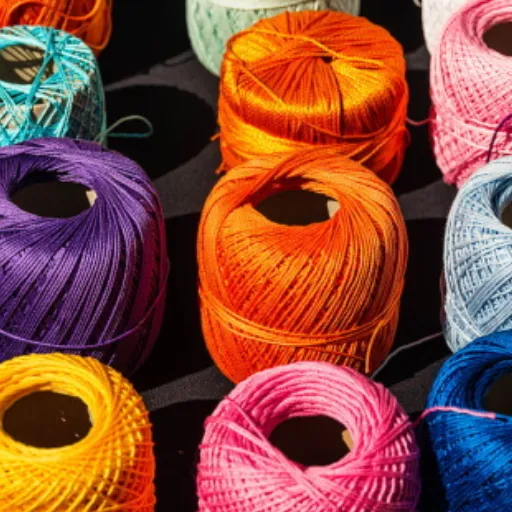
Production of Polyester Fiber
The main method for the production of polyester fibers is polymerization, which is a chemical process where the main raw materials are purified terephthalic acid (PTA) and mono-ethylene glycol (MEG). The raw materials are heated and then react with each other to produce a polymer called polyethylene terephthalate (PET). The PET polymer is the main material used in polyester production, and after it is cooled, it is formed into small pellets or chips. These pellets are the starting point for the production of polyester fibers.
The melting of the pellets is followed by pushing them through a spinneret, which is a device similar to a showerhead but with tiny holes, and the liquid polyester comes out through these holes. The molten polyester that has passed through the holes solidifies quickly, resulting in long fibers. These fibers can be further processed into thin and soft fibers, depending on the application. This involves a significant level of adaptability in developing polyester yarn products for both industrial and consumer needs.
The produced fibers are subjected to several treatments, drawing, and occasionally blending with other materials to get particular qualities such as softness or extra strength. Then the yarn is ready for textiles, packaging, and many other applications as the finished fibers have been spun. The controlled production phases of polyester products guarantee that the final products are strong, elastic, and versatile, which makes them suitable for a variety of uses in modern industries.
Spinning Techniques for Different Yarn Types
Spinning techniques are very specifically designed for each yarn type to be made according to the properties and uses. To be more precise and to mention one of the most popular methods, ring spinning is rated number one and it is a fine, strong, and smooth yarn producer. The process of spinning consists of fiber drafting, twisting and bobbin winding, respectively. Ring spinning is a rather versatile technique and it can produce the very foundations of many different fabrics, e.g. in the case of fabrics for making clothes and home textiles.
Next up in line of these methods is the open-end spinning technique also referred to as rotor spinning. The speed of this spinning technique is greater and at the same time, it is producing a coarser yarn that is more than suitable for its intended use as a bulkier product i.e. towels or denim. Open-end spinning gets rid of the spindle and thus allows for a much greater production efficiency while at the same time providing that the fiber produced has the same strength as needed for that yarn type.
In contrast to the above, air-jet spinning is a very modern way to spin that develops yarn properties that are different and that sometimes are even hard to describe. It twists the fibers using a jet of air under high pressure and thus, the resulting yarn is less fuzzy and much smoother. This method is especially popular when it comes to the production of fabrics that are very light, very comfortable, and thus are the ones used in activewear and casual clothing. Always different spinning techniques equate different pros and cons, thus it is necessary to choose the one that best fits the end-use of the yarn.
| Spinning Technique | Characteristics | Best For |
|---|---|---|
| Ring Spinning | Fine, strong, smooth yarn; versatile | Clothing and home textiles |
| Open-End (Rotor) Spinning | Faster production, coarser yarn, bulkier | Towels, denim, bulky products |
| Air-Jet Spinning | Modern, less fuzzy, smoother, lightweight | Activewear, casual clothing |
Quality Control in Yarn Manufacturing
The process of quality control in yarn manufacturing is very important in making the final product of the expected industry standard and by consumers. This involves conducting regular checks and tests from different production stages to detect and rectify possible defects at an early stage. This way, manufacturers will be able to keep the yarn’s texture, strength, and appearance which are the main characteristics of high-quality fabrics, uniform.
The inspection of raw materials is the very first step of quality control. Fibers, no matter the origin, are subjected to various tests for their evenness, strength, and cleanliness before they get to the spinning phase. The materials already conforming to the standard would then be less of a problem in production. Determining the quality of the fibers through advanced methods such as tensile strength assessment and microscopic analysis is a practice commonly adopted at this juncture.
Moreover, in the spinning and post-spinning stages, the yarn samples are examined for properties like uniformity, twist, and thickness, and thus the possibility of any defects is evaluated. To a great extent, the use of automated systems and sensors constitutes modern technologies that help to quickly identify and correct defects hence leading to less wastage and consistent quality. The wide-ranging quality control practices not only improve the confidence that the final product will be good but also create customer’ loyalty and cut down production expenses by lessening defects.
Choosing the Right Type of Polyester Yarn

Factors to Consider
🎯 Selection Criteria
- Application’s Purpose: Match yarn characteristics to specific project needs. Finer yarns for lightweight fabrics, heavier yarns for durable goods like upholstery or industrial textiles.
- Durability and Quality: Check yarn’s denier and tenacity to determine strength. Consider treatments for UV resistance or water repellency for outdoor or functional use.
- Environmental Impact: Consider recycled polyester yarns as eco-friendlier alternatives. Review certifications or sustainable production practices of manufacturers.
Applications and Use Cases
Almost every industry is using polyester yarn which is why it is very popular and durable. The textile industry utilizes it the most in the various production of clothing, upholstery, and home fabrics like curtains and bedsheets. Its resistance to wrinkles and fast drying made it preferred for activewear and outdoor clothing. Moreover, its strength and flexibility prolonged its use in different areas.
Textiles are not the only area where polyester yarn finds its application, it is being used in the manufacturing of ropes, conveyor belts, and fishing nets in the industry, where its high tensile strength and resistance to water, chemicals, and abrasion are exploited. Polyester yarn’s capacity to stay in shape under stress is what makes it ideal for these difficult applications, thereby ensuring longevity and holding reliability.
Moreover, polyester yarn is being used more and more in the sustainable practices area, especially when made from recycled materials. Recycled polyester is the material of choice for the eco-friendly product lines which include everything from reusable bags, footwear, to outdoor gear. It not only helps with the waste problem but also makes the production processes that are less harmful to the environment more attractive to consumers and industries that are already on the sustainability path or want to switch to it.
Cost Considerations
In the process of comparing the costs of using recycled polyester and the traditional one, it is very much revealed that the former is usually a bit costly. The main reason behind this is the extra treatment done on the waste materials which leads to making them reusable fibers. On the other hand, with the advancements in technology and the continuous rise in sales of eco-friendly products, the difference in cost is slowly but surely closing down. For the industries that are aiming to lessen their negative impact on the environment, the cost of using recycled polyester is hardly ever considered a waste because of its long-term advantages such as waste and emission reduction coming along with it.
💰 Cost-Benefit Analysis
- ✓ Economies of scale can significantly reduce costs of recycled polyester through increased production volumes
- ✓ Government incentives and subsidies support manufacturers making eco-friendly materials more accessible
- ✓ Consumers willing to pay premium for sustainable products with environmental protection benefits
- ✓ Higher initial costs represent long-term investment in attracting eco-conscious consumer markets
Frequently Asked Questions (FAQ)
Q: What are the different kinds of polyester yarn, and what makes them diverse?
A: The variety of polyester yarn consists of multifilament, partially oriented yarn (POY), fully drawn yarn (FDY), textured yarn, slub yarn, polyester staple fiber (spun polyester), high tenacity and recycled PET yarns as the main types. The difference among these polyesters lies in their production and finishing methods such as the melt spinning process, the drawing/boiling stages that determine elongation, breaking strength, durability, etc., and the presence of unique characteristics like slub texture or recycled content.
Q: What is POY (partially oriented yarn) and in which applications is it used?
A: POY is a type of polyester that is made through the melt spinning process and is somewhat oriented when wound; it needs further drawing or texturizing to give it the strength needed for multifilament or textured yarns for fabrics for clothing and industrial yarn applications. POY is a common input in texturizing and attributes good elongation control and cost-effectiveness to its personality.
Q: What makes high tenacity/high strength polyester different from regular polyester?
A: High tenacity polyester yarn which is a cutting-edge polyester type that can withstand breaking and has its durability increased through drawing and heat-setting processes. The use of such yarn in technical textiles and industrial applications that call for resistance to wear, low elongation and long-term performance sets it apart from regular polyester yarn used in everyday fabrics for clothing.
Q: Is it possible to mix polyester yarn with other fibers like cotton, nylon, or spandex?
A: Polyester is a synthetic yarn that, yes, is most of the time blended with cotton yarn for comfort and breathability, nylon for added strength and abrasion resistance, and spandex for stretch and recovery. These mixes bring together the exceptional traits of each fiber type to form fabrics with well-distributed properties, such as longer elongation, higher elasticity, and better resistance to wear.
Q: What is polyester staple fiber and what is its relation to multifilament polyester?
A: Polyester staple fiber is made up of short fibers and is processed and spun like cotton yarn, producing a fabric that has a cotton-like feel. Multifilament polyester consists of many continuous filaments which provide high strength and a smoother surface; staple fiber yarns are chosen when a softer touch or blended look is wanted.
Q: Are recycled PET polyester yarns as strong and durable as virgin polyester?
A: When recycled PET polyester yarn is processed right, it can get very close to the point of hardness and durability of virgin polyester. Recycled PET’s quality is being constantly improved by plastic research and development which makes it suitable for various applications including technical textiles, fabrics for clothing, and industrial yarn, and it also offers environmental advantages over virgin polyester.
Q: What importance does dyeing and finishing have for the different types of polyester yarn?
A: Dye and finishing are processing operations that play an important role in determining the appearance and performance of polyester yarn. Polyester being hydrophobic generally requires disperse dye processes or special finishing treatments to be color fast. Production and finishing steps like heat-setting, texturizing, and coating not only improve properties like resistance to wear and stability but also make it suitable for specific end-uses.
Q: What are the different kinds of polyester yarn that are used in technical textiles and industrial applications?
A: For technical textiles and industrial yarn applications, the preference is given to high tenacity, high strength, low elongation multifilament yarns and specially produced high strength and durability variants. These yarns provide superior breaking strength and are able to resist wear and such uses as safety belts, conveyor belts, and specialty ropes often become the results of advanced melt spinning process parameters and targeted research and development.
References
-
RMCoco: Types of Polyester Yarns (PDF) – Discusses various types of polyester yarns, including monofilament, multifilament, and spun yarns, along with their properties.
-
Textile Yarn: A Guide to Polyester Fiber and Filament – Provides an in-depth guide to polyester yarn types, such as spun and filament yarns, and their applications.
-
Hengli: Exploring Different Types of Polyester Yarn – Highlights three main types of polyester yarns: partially oriented yarn (POY), fully drawn yarn (FDY), and draw textured yarn (DTY).
-
Swicofil: Polyester PET – Grades – Offers details on various polyester yarn grades, including flat FDY, textured yarn, monofilament, and high tenacity yarns.
-
Scribd: Polyester Yarn (PDF) – Covers the main types of polyester yarns, such as POY, DTY, FDY, and high tenacity yarns, along with their characteristics.








